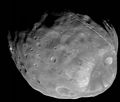Файл:Phobos colour 2008.jpg

Къаддæргонды ас: 636 × 600 пикселы Другие разрешения: 255 × 240 пикселы | 509 × 480 пикселы | 815 × 768 пикселы | 1086 × 1024 пикселы | 2172 × 2048 пикселы | 3500 × 3300 пикселы.
Оригиналы файл (3500 × 3300 пикселы, файлы уæз: 2,72 МБ, MIME тип: image/jpeg)
Файлы истори
Ныххæц датæ/рæстæг-ыл, цæмæй фенай еуæд куыд фæзындис.
| Датæ/рæстæг | Къаддæргонд | Барæнтæ | Архайæг | Фиппаинаг | |
|---|---|---|---|---|---|
| нырыккон | 03:10, 2 апрелы 2018 |  | 3500 × 3300 (2,72 МБ) | Kaldari | more margin on right side |
| 04:47, 13 ноябры 2008 |  | 3374 × 3300 (2,7 МБ) | Fir0002 | == Summary == {{Information |Description=Colour image of Phobos, imaged by the Mars Reconnaisance Orbiter in 2008 |Source=NASA |Date=9 April 2008 |Location=http://www.nasa.gov/mission_pages/MRO/multimedia/pia10368.html |Author=NASA/J |
Файлæй архайд
Ацы файлæй пайда кæны иу фарс:
Ацы файлæй куыд пайда кæнынц
Данный файл используется в следующих вики:
- Использование в af.wikipedia.org
- Использование в an.wikipedia.org
- Использование в ar.wikipedia.org
- المريخ
- فوبوس
- قمرا المريخ
- ويكيبيديا:صور مختارة/الفضاء والكون/نظرة إلى الأعلى
- قائمة أجرام المجموعة الشمسية مرتبة حسب الحجم
- بوابة:علم الفلك/صورة مختارة
- بوابة:المريخ
- بوابة:المريخ/مقالة مختارة/أرشيف
- بوابة:المريخ/مقالة مختارة/2
- قائمة الأقمار الطبيعية
- خط زمني لاكتشاف كواكب المجموعة الشمسية وأقمارها
- ويكيبيديا:ترشيحات الصور المختارة/القمر فوبوس
- ويكيبيديا:صورة اليوم المختارة/أغسطس 2019
- قالب:صورة اليوم المختارة/2019-08-03
- بوابة:علم الفلك/صورة مختارة/73
- معسكر قاعدة المريخ
- ويكيبيديا:صورة اليوم المختارة/يناير 2022
- قالب:صورة اليوم المختارة/2022-01-04
- Использование в ary.wikipedia.org
- Использование в arz.wikipedia.org
- Использование в as.wikipedia.org
- Использование в azb.wikipedia.org
- Использование в az.wikipedia.org
- Использование в be-tarask.wikipedia.org
- Использование в be.wikipedia.org
- Использование в bg.wikipedia.org
- Использование в bh.wikipedia.org
- Использование в bn.wikipedia.org
- Использование в bn.wikibooks.org
- Использование в bs.wikipedia.org
Просмотреть глобальное использование этого файла.





